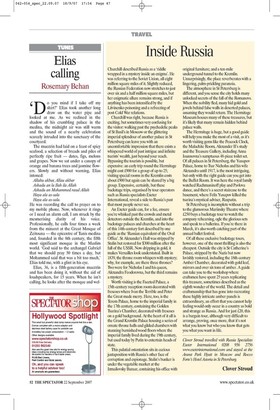Inside Russia
Churchill described Russia as a 'riddle wrapped in a mystery inside an enigma'. He was referring to the Soviet Union, all eight million square miles of it. Slightly reduced, the Russian Federation now stretches to just over six and a half million square miles, but her enigmatic allure remains strong, and if anything has been intensified by the Litvinenko poisoning and a refreezing of post-Cold War relations.
Churchill was right, because Russia is exciting, but sometimes very confusing for the visitor: walking past the psychedelic peaks of St Basil's in Moscow or the glittering imperial splendour of another palace in St Petersburg can leave you with an uncomfortable impression that there exists a whispered world of past intrigue and infinite tsarists' wealth, just beyond your reach. Bypassing the tourists is possible, but expensive: an early trip round the Hermitage might cost £900 for a group of up to 25; visiting special rooms in the Kremlin costs about £900 but again can be shared by a big group. Expensive, certainly, but these backstage trips, organised by tour operators such as Russia specialists Exeter International, reveal a side to Russia's past that most people never see.
An Exeter guide can, for a fee, ensure you're whisked past the crowds and metal detectors outside the Kremlin, and into the backstage palaces and churches at the heart of this 14th-century fort described by one guide as the 'Russian equivalent of the Oval Office'. St Alexander's Hall was stripped by Stalin but restored for $300 million after the fall of the USSR. Now dripping in gold, it makes Versailles look understated. Built in 1839, the throne room whispers with mystery; why, for example, are there three thrones? Two were for Nicholas I and his queen, Alexandra Feodorovna, but the third remains a mystery.
Worth visiting is the Faceted Palace, a 15th-century reception room decorated with frescoes where Ivan the Terrible and Peter the Great made merry. Here, too, is the Terem Palace, home to the imperial family in the 17th century, containing the Golden Tsarina's Chamber, decorated with frescoes on a gold background. At the heart of it all is the Grand Kremlin Palace housing a series of ornate throne halls and gilded chambers with stunning burnished wood floors where the imperial family lived during the 19th century, but used today by Putin to entertain heads of state.
This palatial ostentation sits in curious juxtaposition with Russia's other face of corruption and espionage. Stalin's bunker is under the vegetable market at the Izmailovsky Bazaar, containing his office with original furniture; and a ten-mile underground tunnel to the Kremlin. Unsurprisingly, the place reverberates with a lingering, palm-prickling paranoia.
The atmosphere in St Petersburg is different, and you sense the city holds many unlocked secrets of the fall of the Romanovs. When the nobility fled, many hid gold and jewels behind false walls in deserted palaces, assuming they would return. The Hermitage Museum houses many of these treasures, but it's likely that many remain hidden behind palace walls.
The Hermitage is huge, but a good guide will help you make the most of a visit, as it's worth visiting gems like the Peacock Clock, the Malachite Room, Alexander II's study and the Treasure Gallery, including Anna Ioannovna's sumptuous 48-piece toilet set. Of all palaces in St Petersburg, the Yusupov Palace, home to Tsar Nicholas and his wife Alexandra until 1917, is the most intriguing, but only with the right guide can you get into the Buffet Room. It was here the royal family watched Rachmaninoff play and Pavlova dance, and there's a secret staircase to the basement, where Felix Yusupov killed the tsarina's mystical adviser, Rasputin.
St Petersburg is incomplete without a trip to the glamorous Mariinsky Theatre where £250 buys a backstage tour to watch the company rehearsing, ogle the glorious sets and speak to a ballerina. If you're there in March, it's also worth catching part of the annual ballet festival.
Of all these exclusive backstage tours, however, one of the most thrilling is also the cheapest. Outside the city is St Catherine's Palace, stripped by the Nazis but now lavishly restored, including the 18th-century Amber Chamber, decorated with gold leaf, mirrors and over six tons of amber. A guide can take you to the workshop where craftsmen have spent 25 years replicating this treasure, sometimes described as the eighth wonder of the world. The detail and craftsmanship that has gone into recreating these highly intricate amber panels is extraordinary, an effort that you cannot help feeling would only occur in a country as bold and strange as Russia. And for just £20, this is a bargain tour, although very difficult to arrange, proving, once more, that it's not what you know but who you know that gets you what you want in life.
Clover Stroud travelled with Russia Specialists Exeter International 0208 956 2756 www.eyeterintemationaLcom and stayed at the Ararat Park Hyatt in Moscow and Rocco Forte's Hotel Astoria in St Petersburg.

































































 Previous page
Previous page